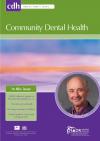Community Dental Health

- Cover Date:
- June 2016
- Print ISSN:
- 0265 539X
- Vol:
- 33
- Issue:
- 2
The mouth as a site of structural inequalities; an introduction
A key premise of sociology is to promote fairness, justice and equity. These goals are synonymous with those of dental
public health organisations throughout the world. However, an additional purpose of sociology is to reveal invisible
points of observation, particularly those related to power. In the ï¬ve papers that follow, we seek to contribute to the
discourse around oral health-related inequalities through the lens of power and human agency. Based on the seminal
work of Davis in the 1970s, Lukes’ three-dimensional power framework and Goodley’s work on dis/ability, we present
a range of papers from the United Kingdom, Australia and New Zealand that give examples of structural power and
disadvantage as they relate to the oral health experiences of Aboriginal Australians, dental school curricula and encounters in the dental practice. The papers formed the basis of a symposium entitled ‘A sociological/ anthropological
perspective on oral health inequalities’ at the 94th General Session of the International Association of Dental Research
held June 2016 in Seoul, Korea. This symposium was a product of many requests over the years for there to be a
speciï¬c research session focussing on the role of sociology and anthropology in oral health inequalities, especially as
they relate to disadvantaged populations, dental service provision and dental school curricula.
doi:10.1922/CDH_3723Jamieson01
- Article Price
- £15.00
- Institution Article Price
- £
- Page Start
- 151
- Page End
- 151
- Authors
- Lisa M. Jamieson
Articles from this issue
- Title
- Pg. Start
- Pg. End
- Child oral health in migrant families: A cross-sectional study of caries in 1-4 year old children from migrant backgrounds residing in Melbourne, Australia
- 100
- 106
- Feasibility, utility and impact of a national dental epidemiological survey of three-year-old children in England 2013
- 116
- 120
- A bi-level intervention to improve oral hygiene of older and disabled adults in low-income housing: results of a pilot study
- 127
- 132
- Caries and costs: an evaluation of a school-based fluoride varnish programme for adolescents in a Swedish region
- 138
- 144
- Examiner reliability in fluorosis scoring: a comparison of photographic and clinical methods
- 145
- 150
- Do ‘poor areas’ get the services they deserve? The role of dental services in structural inequalities in oral health
- 164
- 167
